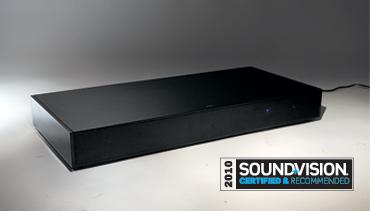ZVOX Incredibase 575 Soundbar

Connecting and configuring a home theater rig can be pretty daunting. Just one quick glance at those long rows of connectors covering the back panel on most A/V receivers is enough to scare away many potential buyers. That’s a problem, because while TV picture quality has made huge strides over the last few years, TV sound has been degraded by manufacturers’ use of smaller and wimpier speakers. In many cases, a sleek new flat-panel set’s built-in audio may be so tinny that an external system is almost a requirement.
Systems that combine multiple speakers and amplifiers in a single box have become a popular solution, and no company has done more than Zvox to promote this approach with its soundbar and “base” audio systems. Its newest flagship model, the $699 IncrediBase 575, is basically a pumped-up version of the Z-Base 550 that we checked out this time last year. Looking like a 550 that’s been working out at the gym, the 575 has more than double that model’s amplifier power, significantly larger main drivers, and a pair of downward-firing 6½ -inch subwoofers in place of the 550’s single 5¼ -inch job.
Big sound generally requires a big box, and the IncrediBase 575 is bigger than just about any other all-in-one system I’ve encountered. But at 5 inches high, it still looks pretty sleek from the front, while its 36-inch width is a perfect match for most flat-panels it’s likely to be paired with. (The maximum supported screen size is 65 inches, according to Zvox.) One issue, however, is its 16½ -inch depth, which at first glance seems a better match for the old tubetype TVs than a skinny new LCD or plasma. As with its smaller brother, the 575 was designed to serve as a pedestal for your TV, and its large flat-top surface can handle sets up to around 140 pounds.
The 575’s face is covered with a perforated metal grille that endows it with a suitably hightech look, with no visible controls or displays aside from a couple of LEDs peeking through the metalwork to indicate operational status. The entire box is supported by a pair of legs in the rear corners, along with a bar that runs the full width of the front edge. The resulting gap gives the downward-firing subs about an inch of breathing room, although it also means that you should avoid jamming the 575 into a very tight wall unit.
SETUP
Glance around back and you’ll find that the 575 sports a grand total of just five RCA jacks, including two stereo analog inputs. (Both inputs are connected in parallel, which means you can hook up and listen to an iPod when the TV is switched off.) The fifth jack delivers a full-range mono output to an external subwoofer should you decide that the IncrediBase’s bass isn’t quite so incredible. For those who also require a digital input to connect a TV or other device, Zvox recently came out with a new version of the 575, the 575 HSD ($750), that adds optical and coaxial digital ports.
If easy hookup and operation are important to you, it’s hard to imagine anything much simpler than the 575: All you’ll need to do in most situations is connect a set of cables from your TV’s stereo audio output. Although no configuring is required, a small 11-button remote lets you adjust what few sonic options the 575 does offer. And if the thought of yet another remote leaves you cringing, you’ll be happy to know that once you’ve made those few simple tweaks, the remote can be stashed away, leaving the 575 to operate automatically via its signal- sensing power switch.
Once you get things up and running, there are a total of four sonic adjustments you can make. Volume is self-explanatory, and should be left turned up fairly high if you intend to control the system’s volume using your TV’s remote. Subwoofer and treble level are also easy to understand, although it can be a bit tricky to tell where you are in the adjustment range. A blue LED flashes when you change the level, changing to solid blue as soon as you reach either extreme. (Since I usually make these adjustments by ear, I never got too worried about where I was on the control scale.) In my room, I felt that things sounded best with the treble control somewhere near the middle of its range and the subwoofer up near the top. The final control, PhaseCue, will likely be the least familiar one for most users. Basically, it changes the amount of surround information you hear, controlling the balance between direct sounds, such as movie soundtrack dialogue, and ambient effects. Like Goldilocks with her porridge, you’ll know when it’s just right: With too much PhaseCue, dialogue tends to get buried under surround effects, while too little makes things sound dry and monophonic.












































